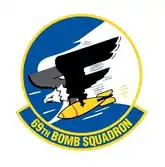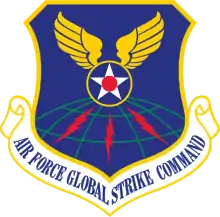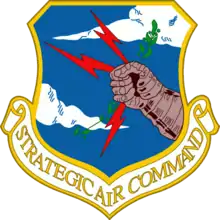69th Bomb Squadron
The 69th Bomb Squadron is an active United States Air Force unit. After being inactivated on 31 December 1993, it was reactivated on 3 September 2009 at Minot Air Force Base, and assigned to the 5th Bomb Wing. The squadron operates Boeing B-52H Stratofortress aircraft.
69th Bomb Squadron
 | |
|---|---|
.jpg.webp) B-52H 69th Bomb Squadron "Knighthawks" Minot AFB | |
| Active | 1940–1993; 2009-present |
| Country | |
| Branch | |
| Type | Squadron |
| Role | Bombardment |
| Part of | Global Strike Command |
| Garrison/HQ | Minot Air Force Base |
| Nickname(s) | Knighthawks |
| Colors | Gray/yellow |
| Engagements | OIR OFS Southwest Pacific Theater Desert Storm[1] |
| Decorations | Distinguished Unit Citation Air Force Outstanding Unit Award Philippine Presidential Unit Citation[1] |
| Insignia | |
| 69th Bombardment Squadron emblem (approved 20 January 1945)[1] |  |
History
World War II
The lineage of the 69th Bombardment Squadron pre-dates the US entry in World War II. Activated and equipped with Douglas B-18 Bolo and early-model Martin B-26 Marauders. After the Japanese Attack on Pearl Harbor, squadron was engaged in antisubmarine operations over the mid-Atlantic coast. Assigned to the 38th BG and equipped with the Martin B-26. Separated from the 38th BG as an independent squadron circa May/June 1942 and assigned to Seventh Air Force forward elements in the South Pacific area. Participated in the Battle of Midway. Re-equipped with B-25 Mitchells and assigned to 42nd BG, later Thirteenth Air Force and FEAF for the remained of WWII.
Attacked enemy forces in the Philippines during early 1945 as part of the liberation from Japanese control; continued combat missions until the Japanese capitulation in August 1945. Became part of the Fifth Air Force forces in Occupied Japan in 1946 before being demobilized and inactivated in May 1946.
The 69th was awarded a Distinguished Unit Citation for its pre-invasion bombing of Balikpapan between 23 and 30 June 1945. Balikpapan was a center for oil refining on Borneo held by the Japanese. These attacks included bombing and strafing enemy shore installations. The round trip to the target was over 1700 miles and was among the longest flown by medium bombers during the war. Pre mission experiments determined that the squadron's bombers could carry a bomb load over this distance with fuel tanks installed in their radio compartments despite having to take off from a runway damaged by enemy action. Four of the missions encountered severe tropical weather fronts. Despite intense and accurate flak, the squadron destroyed gun positions, warehouses, roadblocks, fuel and ammunition dumps, a radar station as well as huge stores of gasoline and oil which the enemy had placed in position to be released into shallow pits oil the beach and ignited when the Australian ground troops made their assaults. The group attacked the beach while naval underwater demolition teams operated offshore without losing a man. The attacks were so effective that the Australian Seventh Division was able to come ashore without enemy opposition.[2]
Cold War
The 69th was reactivated as a Strategic Air Command Convair B-36 Peacemaker bombardment squadron in 1953. Engaged in worldwide training missions with the B-36 until 1956 when re-equipped with the jet Boeing B-52 Stratofortress. During the Vietnam War the squadron deployed personnel and aircraft to Andersen Air Force Base, Guam and U-Tapao Royal Thai Navy Airfield, Thailand, for Operation Arc Light missions from 1968 to 1975.[3] Maintained nuclear alert until the end of the Cold War.
.png.webp)
Aircraft and personnel deployed to 1708th Provisional Bombardment Wing, Prince Abdulla AB, Jeddah, Saudi Arabia, Aug 1990-Mar 1991 (Operation Desert Storm); additional aircraft and personnel deployed in Dec 1990-Mar 1991. Aircraft and personnel deployed to 4300th Provisional Bombardment Wing, Diego Garcia AB, British Indian Ocean Territories, Aug 1990 - Mar 1991. Last B-52G departed Loring AFB on 18 Nov 1993[3] and base closed on 30 September 1994.[4] Inactivated in 31 Dec 1993 with the drawdown of US Strategic forces.[3]
Post-Cold War
The 69th was reactivated as Minot AFB's second B-52H squadron on September 3, 2009 as part of Air Combat Command and transitioned to Air Force Global Strike Command in early 2010.[5]
November 2010 saw the squadron deploy six B-52H Stratofortresses to Andersen AFB, Guam for the first since the Vietnam War as part of U.S. Pacific Command's Continuous Bomber Presence.[6]
On June 5, 2015, the 69th BS deployed three B-52H Stratofortress bombers to RAF Fairford for two weeks for exercises BALTOPS 15 and SABER STRIKE 15 taking place in Europe.[7]
Four B-52H Stratofortress bombers from the 69th Bomb Squadron were flown Nellis AFB to participate in exercise Red Flag 15-3, that took place 13–31 July 2015.[8]
February 2016 Six B-52 Stratofortresses from the 69th BS took part in Exercise Combat Hammer, a week long annual air-to-ground combat training exercise. During the exercise, the aircraft dropped laser-guided GBU-12 and GPS-guided GBU-38 bombs on moving targets on the bombing range at Eglin Air Force Base, Florida. The exercise evaluates everything from building the bomb, to loading the bomb, to planning the sortie, to dropping the weapon, to hitting the target[9]
On May 19, 2016 8:32 a.m a B-52H Stratofortress serial number 60-0047 "Neanderthaul",[10] crashed on takeoff at Andersen Air Force Base in Guam. The aircraft which was assign to 69th Expeditionary Bomb Squadron and deployed to Andersen AFB as part of the U.S. Air Force's Continuous Bomber Presence. The main landing collapsed and the chute failed to deployed fully during the aborted takeoff and the aircraft came to rest 300 ft from the end of the runway. All seven crew escaped safely, with one crew member sustaining minor injuries.[11]
During Global Strike Challenge 2017 the squadron won both the LeMay Trophy, for the best in bomber operations and the Linebacker Trophy, for the best B-52 squadron.[12]
February 2018 a B-52H from the 69th BS that was stationed Al Udeid AB set a new world record by dropping 24 precision guided bombs on Taliban targets, beating the previous record of 19 (also held by a B52H).[13] Codename name for the mission was "Operation Jagged Knife", part of a larger effort to target Taliban drug and financial infrastructure.[14]
On August 13, 2019 a B-52H from the 69th BS assigned to the 69th Expeditionary Bomber Squadron temporarily based at Andersen Air Force Base, Guam assisted in the search for the Indonesian-flagged fishing vessel KM Aleluya. Adrift for 10 days without food, water or electricity, the crew was safely rescued by the AMVER vessel Isl Star, approximately 172 miles northwest of Palau.[15]
Lineage
- Constituted as the 69th Bombardment Squadron (Medium) on 20 November 1940
- Activated on 15 January 1941
- Redesignated 69th Bombardment Squadron, Medium on 19 September 1944
- Inactivated on 10 May 1946
- Redesignated 69th Bombardment Squadron, Heavy on 19 February 1953
- Activated on 25 February 1953
- Redesignated 69th Bomb Squadron on 1 September 1991
- Inactivated on 31 December 1993
- Activated on 3 September 2009[1]
Assignments
- 38th Bombardment Group, 15 January 1941
- 42d Bombardment Group, 26 February 1943 – 10 May 1946
- 42d Bombardment Wing, 25 February 1953 – 1 September 1991
- 5th Bombardment Wing, 3 September 2009 – present[1]
Stations
|
|
Aircraft
- Douglas B-18 Bolo, (1941)
- Martin B-26 Marauder, (1941–1943)
- North American B-25 Mitchell, (1942–1946)
- Douglas A-26 Invader, (1942–1946)
- Convair B-36 Peacemaker, (1953–1956)
- Boeing B-52C Stratofortress (1956)
- Boeing B-52D Stratofortress (1957–1959)
- Boeing B-52G Stratofortress (1959–1991)
- Boeing B-52H Stratofortress (2009–present)
Decorations
- Distinguished Unit Citation: Balikpapan, Borneo, 23-30 Jun 1945.
- Philippine Presidential Unit Citation: 7 Dec 1941-10 May 1942, 17 Oct 1944-4 Jul 1945.
- Air Force Outstanding Unit Awards: 1 Jul 1974-30 Jun 1975; 1 Jul 1982-30 Jun 1984; 1 Jul 1986-30 Jun 1988; 1 Jan 1992-31 Dec 1993.[16]
See also
References
Notes
- Kane, Robert B. (23 November 2009). "Factsheet 69 Bomb Squadron (ACC)". Air Force Historical Research Agency. Retrieved 13 December 2017.
- Cohn, Preface (quoting the citation for the award)
- "69 Bomb Squadron (ACC)". Retrieved 30 August 2019.
- "LORING HISTORY". Retrieved 30 August 2019.
- "AIR FORCE GLOBAL STRIKE COMMAND". USAF Fact Sheet. Archived from the original on 17 February 2013. Retrieved 31 May 2013.
- "Minot's Nighthawks fly to where America's day begins". Retrieved 30 August 2019.
- "Fairford Bomber Deployment 2015". Retrieved 31 August 2019.
- "MAFB Red Flag 15-3 participants return". Retrieved 30 August 2019.
- "B-52s drop bombs in Florida for exercise Combat Hammer". Retrieved 30 August 2019.
- "1960 USAF Serial Numbers". Retrieved 2 September 2019.
- "Air Force: Bird scare led to aborted takeoff that wrecked B-52". Retrieved 3 September 2019.
- "Reigning 2017 Legacy and Rotational Trophy Winners". Retrieved 30 August 2019.
- "Air Force Sets Another B-52 Smart Bomb Record in Afghanistan". Retrieved 30 August 2019.
- "The B-52 bomber is leaving the Middle East after a record-breaking run against ISIS". Retrieved 30 August 2019.
- "Andersen's B-52 assists in search and rescue". Retrieved 30 August 2019.
- "69 Bomb Squadron (ACC)". Retrieved 28 August 2019.
Bibliography
![]() This article incorporates public domain material from the Air Force Historical Research Agency website http://www.afhra.af.mil/.
This article incorporates public domain material from the Air Force Historical Research Agency website http://www.afhra.af.mil/.
- Cohn, Major R. H.; et al. (2013) [1946]. The Crusaders: A History of the 42nd Bombardment Group (M) (Kindle ed.). Baton Rouge, LA: Army & Navy Pictorial Publications. ASIN B00BRSWTDA. Retrieved 8 November 2014.
- Maurer, Maurer, ed. (1982) [1969]. Combat Squadrons of the Air Force, World War II (PDF) (reprint ed.). Washington, DC: Office of Air Force History. ISBN 0-405-12194-6. LCCN 70605402. OCLC 72556.


.svg.png.webp)
